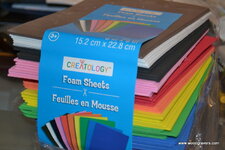One of the problems with CA from various manufactures is that, they don't tell you the viscosity of the CA in the bottles, one of the reasons why I started using E-Z Bond products that Mannie (Monty) did until very recently sell (now in the hands on Exotics/Ed), is that they supply from the thinnest to the thickest CA available out there and the bottle are clearly labeled with its viscosity, measure is "cups".
The 5 cup -super thin (the thinnest) is the very best for wood soaking, the 50 cup - thin is ideal to use on the first couple of coats on the CA finishing process. Then the 300 cup is what I use for the main coating using the craft foam. The 700 cup and 1500 cup are little too thick for CA coating, you may get away with them in cold environments but certainly not in hot environments...!
This is not a rule, this is ONE of the dozens of options and this is, the way I do it however, while the most common mistake is to not put enough coats before the sanding starts, the major culprit is people trying to smooth all the ridges but sanding while the lathe in turn turning 100 miles an our...!
The small ridges, which are normal after many CA coats, should be smoothed out with the lathe turn off and use 400 gri twet and dry sand paper, sanding with the grain, which is in the majority of cases, through the blanks length. After these ridges are 90% removed, then the lathe can be turned on and the next grits applied in a rotating fashion.
HOWEVER, there is one small trick to make those ridges smooth out by 50% or more, before touching it with the sandpaper and there is, use the 50 cup CA capabilities to set quit fast, and use it to coat the blank another 4 or 5 times before the sanding starts.
What this does, and is important that is done immediately after the medium CA application/coats, as the ridges at the point are not set/hard so the thin CA is like using a soft brush of solvent to smooth a thick coat of varnish or paint that has deep brush marks, and extra material in some spots, which in this case are the ridges.
The thin CA will flatten part of those ridges by filling in between valleys, resulting in a much less rough surface to smooth with the sand paper, while adding extra thickness to the finish so less risk of sanding through...!
I keep repeating this over and over, giving a rich deep gloss to a pen barrel/balnk, is the easiest things to do, as soon as you done it enough successful times, it becomes second nature and you get the same result time and time again. The problem is, the initial learning process is agonizingly sticky and messy, putting people off from the start when, all it takes is, a hand full of cheap blanks, invest in a couple of 2oz bottles, thin and medium and some accelerator, dry sandpaper from 240 to 400 and wet and dry sand paper, 600-800-1000-1200-1500-2000 & 2500, some good polishing compound, a couple of paper towels, some craft foam and a day put a side for "PRACTICE".
Put the blank between centers and get it round, start your first attempt while you still have lots of wood, if you don't have many practice blanks, as soon as you done all your steps and mentioned, regardless if it come out OK or not, turn it down again to clean wood and start again, thing on each step before you execute it, if the first time didn't work too well, who cares, try again slightly different, and again, and again until you know that, you have mastered it and you can repeat the process any time you feel like...!
At this point stop and have a break, so make yourself a cup of coffee a drink of water, whatever takes you fancy, simply seat down and relax for an our or so then, go and make yourself a real pen, by the time you are done with it, you will realize that you took yourself over the fear and anxiety of having to do a nice CA finish, from that moment on, your CA finish problems disappear, unless you took a short cut and or, the CA/accelerator/or other product used, as become contaminated or lost its original characteristics but that, is beyond your control and easily rectified, it happens to all of us...!
This is my story, and I stick to it...!
Cheers
George

